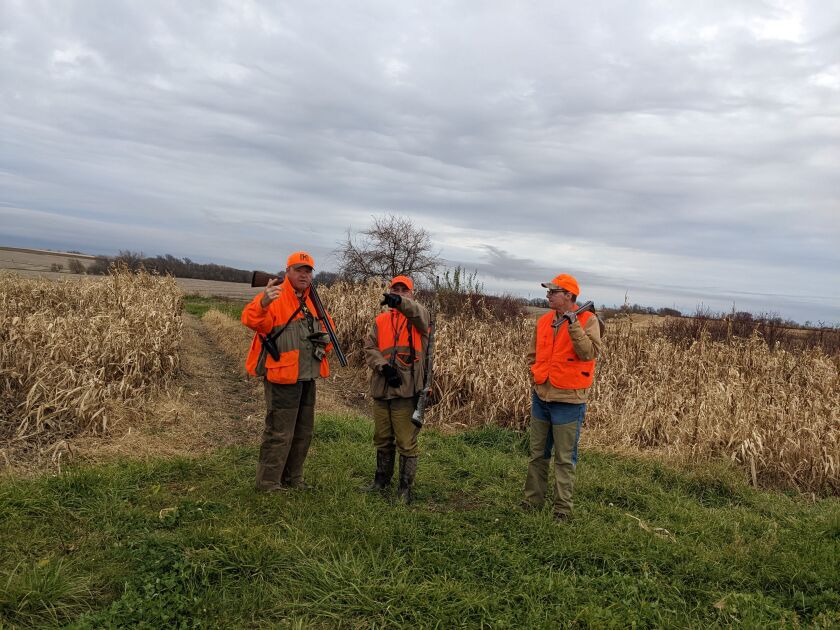
LEE, Ill.—As we barreled north on I-355, I asked Kyle Danhausen why his 3-year-old German shorthair was named Jacob.
“Ezekiel [a puppy] had to be put down at 12 weeks with an enlarged heart,” he said. “It was a horrific event for us.”
But it brought Danhausen and his wife Dany together.
They put Zeke down on a Friday and knew they had to get “the hell out of this place.” They headed east, stopped at Pearson’s Bordertown Bakery in Momence, then “wound up in Crown Point [Indiana].”
They went to Bona’s Kennels, breeders of German shorthairs in North Judson, Indiana.
“This dog picked us, he was coming home with us, a God-inspired event,” Danhausen sad. “He has a remarkable sense of humor. My wife came up with the name.”
Seems inspired as Ezekiel means God strengthens and Jacob means to follow among other things.
Before you think we were headed to a revival, we were going to hunt Steward Pheasant Habitat Area in Lee County.
For the second straight year, Pete Lamar drew a permit there. Lamar and I have been in an ad hoc group for nearly 20 years for drawings in Illinois’ Free Upland Game Hunting Permit program. The annual application period is in August.
Anyone in our group drawing a permit, goes down our list seeing who can hunt that day. Permit holders may take three other hunters (five others at the bigger sites) for the day.
I haven’t drawn a permit in years, leading me to wonder if I was blackballed. More likely it’s my addiction to applying for the crown jewels of the 646-acre Saybrook PHA and the 635-acre Sibley PHA.
“You might have a better chance on Powerball,” Danhausen cracked.
Lamar, who lives in the western suburbs, applies for sites near him.
This was the first time Danhausen hunted with us. I invited him in part because I knew he and his wife have great hunting dogs. Steve Komes joined us for the second straight year and again brought Maggie, his lion-hearted 9-year-old Springer.

Kyle Danhausen (left), Steve Komes and Pete Lamar discuss the plan for the next push Wednesday while hunting at Steward Pheasant Habitat Area.
Dale Bowman
Waiting for dawn, we devised our opening strategy for south/southwest winds. The 80-acre site is a mix of strips of standing corn, alfalfa/clover patches, chunks of cool season grasses, prairie restoration, a small lake and framing fencerows.
We hadn’t gone far before Maggie, a flusher, busted a hen silhouetted against the dawn. Then Jacob, a pointer, held a point for about 30 seconds.
“That’s all I care about, him holding the point,” said Danhausen, who held his double-barrel shotgun open over his shoulder as he walked until Jacob pointed.
A rooster was missed. More hens flushed, a rooster flew wild and into the wind across a country road. I flushed and missed a rooster.
After two hours, we had flushed three roosters (missing two) and eight hens. We took a break with candy bars, coffee and water. The dogs were watered.
As we started the final walking, a rooster flushed out of range. We would flush four roosters (missed two) and 10 hens.
We had many birds, notably a short-eared owl, and an unknown mammal. A rabbit, groundhog, mouse or vole, we couldn’t tell as the dogs lunged for it.
When they weren’t hunting, I swear Jacob, as he nosed Maggie’s rear, hummed a canine version of Ronnie McDowell’s classic.
It was time.
Plus I was dragging after five hours of slogging through high cover and standing corn.
Bottom line: if a male pointer and a female flusher can work together the first time they met, there’s hope for Republicans and Democrats.

The varied habitat at Steward Pheasant Habitat Area.
Dale Bowman